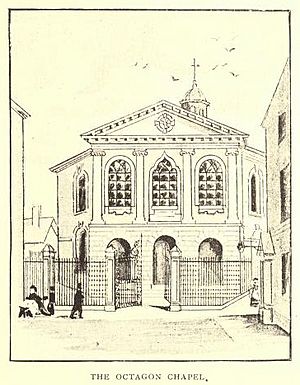Octagon Chapel, Liverpool facts for kids
The Octagon Chapel, Liverpool was a special church in Liverpool, England. It opened in 1763. This church was for people called Nonconformists. This means they were Protestants who did not follow the official Church of England.
The chapel was started by two local church groups. These were from Benn's Garden and Kaye Street chapels. Their goal was to use a new kind of church service. This service would not be tied to just one specific group. A key person in starting the chapel was Thomas Bentley. He also helped create the new service style.
Contents
Why Was the Octagon Chapel Built?
In the mid-1700s, the number of Nonconformists in Liverpool was getting smaller. Many people were joining the Church of England instead. Some church leaders in Lancashire wanted to change this. In 1750, they suggested creating a new, set way to hold church services. They hoped this would make services more appealing.
A minister named John Brekell from Kaye Street Chapel did not agree with this idea. He had been a minister there for almost 30 years. But even with his objections, the new service book was created. The Kaye Street Chapel had been around since 1707. It belonged to a group called the Warrington presbyterian classis.
The Benn's Garden Chapel was another Nonconformist church. It was built in 1727 for a minister named Henry Winder. In 1763, its minister, John Henderson, joined the Church of England. Then, William Enfield became the only minister there. Many local business people attended this chapel.
Even though Brekell and Enfield had different religious views, they worked together. They created their own book of songs for Christian worship. It was called A New Collection of Psalms Proper for Christian Worship (1764).
In 1775, Liverpool had about 35,000 people. Besides the two Presbyterian chapels and the Octagon, there were other places of worship. These included a Methodist chapel, two Baptist churches, a Quaker meeting-house, a Catholic chapel, and a synagogue.
How Was the Chapel Designed?
As its name suggests, the Octagon Chapel had eight sides. It was similar to the Octagon Chapel in Norwich, built in 1756. The Liverpool chapel was designed by Joseph Finney. It was built in an area called Temple Court.
Nicholas Clayton was a minister with Unitarian beliefs. He was invited to be the first minister at the Octagon Chapel. He shared this role with Hezekiah Kirkpatrick. The people who went to the chapel were sometimes called "Octagonians."
The chapel's success relied a lot on Thomas Bentley. He later moved to London. The new, experimental church service did not get as much support as hoped. Many people from the founding churches did not want to use a service like the Book of Common Prayer.
What Happened to the Chapel?
The Octagon Chapel was sold in 1776. A clergyman named Rev. Plumbe bought it. He was the Rector of Aughton. The building then became an Anglican church, called St Catherine's.
Several Anglican ministers served there over the years. These included Rev. John Plumbe, Rev. Wilmot, and Rev. Brownlow Forde. Later, RK Milner and Thomas Bold served together.
The building was torn down in 1820. The Corporation of Liverpool had bought it. A Fire Police Station was built on the same spot.
After 1776, Nicholas Clayton moved to Benn's Garden Chapel. He shared the ministry with Robert Lewin until 1781. Lewin's church group was later seen as Unitarian. Important people like William Rathbone and William Roscoe were part of this group.
This group eventually moved to Renshaw Street Unitarian Chapel. The Benn's Garden chapel was sold to the Wesleyan Methodists. Today, the Ullet Road Unitarian Church traces its history back to Henry Winder's original church group. In 1786, Kirkpatrick became the minister of Park Lane Chapel near Wigan.
The Liverpool Liturgy
The special church service used at the Octagon Chapel became known as the Liverpool Liturgy. It was written by Philip Holland and Richard Godwin. It was published in 1763, edited by John Seddon.
Some hymns in the liturgy were chosen from a writer named Elizabeth Scott. Later, John Broderip arranged her music. Even Thomas Jefferson, a future US President, knew about the psalms from the Octagon Chapel.
The Liverpool Liturgy was adopted by a well-known minister, David Williams, for his church in Exeter. However, the liturgy caused arguments and divided people. Seddon and Holland were founders of the nearby Warrington Academy. John Taylor, a teacher there, was against the liturgy even before it was published.
Seddon and Taylor had a big disagreement about the ideas of Francis Hutcheson. These ideas were meant to be part of the teaching at the academy. The liturgy itself was based on Hutcheson's ideas.
In 1762, Thomas Bentley thought the new liturgy was "very chaste and yet animated." But the basic idea of the liturgy and the chapel was still debated. Seddon himself decided not to become the chapel's minister. He preferred spontaneous prayer over a formal service.
Some people thought a set liturgy would attract Anglicans with open minds. They also thought it would stop Nonconformists from thinking too freely. But these ideas remained just theories. The success of the Methodist movement at the time seemed to show otherwise. Job Orton, who supported Taylor, even said the liturgy hurt the reputation of Warrington Academy.
Over time, the Octagon Chapel's liturgy influenced Anna Barbauld, a writer. She grew up at Warrington Academy. Her father, John Aikin, was a teacher there and agreed with Seddon.
However, others criticized the liturgy. Following Orton's opinion, they said it was "scarcely a Christian Liturgy." They felt it barely mentioned Christ and left out the Holy Spirit. Some even called it an "almost deistical composition." This view was also found in Charles Buck's Theological Dictionary around 1820.
See also
Other Unitarian churches in Liverpool include:
- Hope Street Unitarian Chapel
- Renshaw Street Unitarian Chapel
- Toxteth Unitarian Chapel
- Ullet Road Unitarian Church
Other eight-sided Unitarian churches include:



